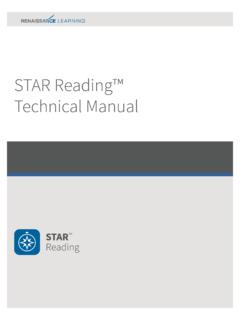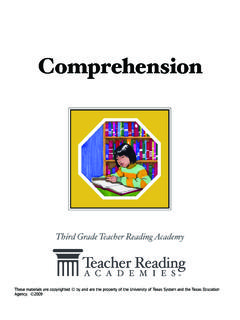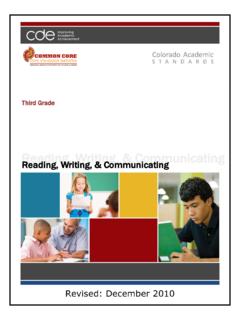Transcription of Grade Three Reading Proficiency Indicators
1 Three Reading Proficiency IndicatorsCommon Core State Standards (CCSS)A student s ability to read at Grade level by the 3rd grade is the #1 indicator whether or not that student will complete high school. Annie E. Casey FoundationLearning to read is the focus of the early elementary-school years. By the end of Grade Three , students are expected to have learned to read. By fourth Grade , a dramatic shift occurs: Students are expected to put those Reading skills to use by Reading to learn in all subject areas. The amount of time on Reading instruction decreases as students advance through school. As a result, it is extremely difficult for students to catch up if they cannot read well by the end of third Grade . Renaissance Learning is ready to assist states and their educators by providing a picture of a child s Reading Proficiency from kindergarten through Grade Are the Reading Proficiency Indicators ?Through research and empirical data, Renaissance Learning has identified a list of skills that designate Reading Proficiency at each Grade level from kindergarten through Grade Three .
2 These skills are the Reading Proficiency Indicators . The Reading Proficiency Indicators , paired with STAR Early Literacy Enterprise, are one tool a trusted, valid, and reliable one that educators can use to gather and report objective data with respect to Grade -level literacy Proficiency . That data can drive the development of relevant instructional opportunities and minimize achievement to Use the Proficiency IndicatorsUnderstanding a student s level of Proficiency with the indicator skills provides valuable insight into the skill instruction a student may need. After you administer a STAR Early Literacy Enterprise assessment, use the Grade 3 Reading Proficiency Scores table to identify whether a student is on track for meeting the end of Grade 3 Reading Proficiency 3 Reading Proficiency ScoresMastery StandardPre-KGrade KGrade 1 Grade 2 Grade to use the table: The Mastery Standard indicates the expected percent of correct answers.
3 The score identifies the point on the scale where a student meets the Mastery Standard. For example, a Grade 1 student with a score of 680 is expected to answer 60% of the questions on a Grade 1 early literacy and numeracy test correctly. Determine the Mastery Standard that you will use. Locate the student s Grade level and score. A scaled score higher than the Reading Proficiency Score indicates that the student is on track for learning the Reading skills expected at that Grade . A scaled score below the Reading Proficiency scale indicates the student does not yet have the expected Grade -level Reading skills. To help students who do not yet have the Reading skills expected, focus on the Proficiency Indicators listed below for each Grade level. Each Proficiency indicator is associated with a Core Progress learning progression skill. You will find guidelines and resources for teaching the skills in the learning progression. Four customizable form letters are included for reporting to parents on progress and to suggest powerful ways to aid their student s literacy development at Skills Grade 3 KGrade 3 indicator SkillsCore Progress Learning Progression SkillIdentify common prefixesIdentify the meanings of Grade -level appropriate affixes ( , dis-, non-, re-, un- and -ful, -ly, -ness) and infer how they affect the meanings of wordsIdentify common derivational suffixesIdentify the meanings of Grade -level appropriate affixes ( , dis-, non-, re-, un- and -ful, -ly, -ness) and infer how they affect the meanings of wordsKnow the meaning of common prefixesIdentify the meanings of Grade -level appropriate affixes ( , dis-, non-, re-, un- and -ful, -ly, -ness)
4 And infer how they affect the meanings of wordsKnow the meaning of common derivational suffixesIdentify the meanings of Grade -level appropriate affixes ( , dis-, non-, re-, un- and -ful, -ly, -ness) and infer how they affect the meanings of wordsDecode words with common Latin suffixesDecode words with common Latin suffixes, such as the -or in elevator or -ment in government, and identify the meanings of the wordsDecode multisyllable wordsDecode increasingly difficult multisyllable words by identifying syllable patterns ( , transportation)Read words with irregular spellingsRead Grade -level irregularly spelled sight words automatically ( , certain, notice)Read texts with purpose and understandingIdentify purpose for Reading ( , for enjoyment, to answer a question, to learn about a subject) and comprehend on-level texts demonstrated by talking about interesting characters or surprising events, writing an answer to the question, or summarizing what was learnedRead on-level text accurately and fluentlyRead on-level texts aloud at the estimated oral Reading fluency (ORF)
5 To meet Grade -level benchmarks word recognition and understandingConfirm or correct understanding of a word or a larger text by using context clues, including both words and text structures, by using phonics, particularly understanding of word morphology, and by slowing Reading pace, and/or rereadingSelf-correct word recognition and understandingConfirm or correct understanding of a word or a larger text by using context clues, including both words and text structures, by using phonics, particularly understanding of word morphology, and by slowing Reading pace, and/or rereading Determine the meanings of Grade -level words using knowledge of synonyms Explain the differences in shades of meaning between related words and synonyms, especially those that describe states of mindDetermine the meanings of Grade -level words using knowledge of antonymsName antonyms or near antonyms for Grade -appropriate words ( , happiness/sadness)Determine the meanings of Grade -level multi-meaning wordsUse the correct homophones ( , hole/whole, weak/week) and homographs/multiple-meaning words ( , hard, chest) and determine their meanings in Grade -appropriate texts using sentence context or prior knowledge of spellingsGrade 2 indicator SkillsCore Progress Learning Progression SkillDistinguish between long and short vowel soundsDistinguish long vowel sounds from short vowel sounds in spoken single-syllable words ( , pick the picture that has the long /a/ from picture of a mat, cane, and can) Recognize common vowel teamsDecode words with long vowel digraphs ( pick the word need: nede, nead, need) and isolate the spelling pattern used ( , pick the vowel team that spells the long a sound in tail.)
6 Ae, ai, au)Decode two-syllable words with long vowelsDecode words with long vowels syllable patterns (V-CV and VC-V) by using principles of chunkingDecode words with prefixes and suffixesDecode words with common affixes ( , un-, re-, over-, -er, -est) and familiar base wordsRead words with irregular spellingRead Grade -level sight words automatically ( , again, could, every)Read texts with purpose and understandingIdentify purpose for Reading ( , for enjoyment, to answer a question) and comprehend on-level texts demonstrated by rereading favorite parts to self or other audience or by answering the pre- Reading questionRead on-level text accurately and fluentlyRead on-level texts aloud at the estimated oral Reading fluency (ORF) to meet Grade -level benchmarksGrade 3 indicator SkillsCore Progress Learning Progression Skill* Skill is predictive of later literary successConfirm word recognition and understandingConfirm or correct understanding of a word in context through the use of various text features ( , illustrations, bold print), phonics ( , sounding out words, especially initial and final letters), and by applying repair strategies ( , slowing Reading pace and/or rereading aloud)Self-correct word recognition and understandingConfirm or correct understanding of a word in context through the use of various text features ( , illustrations, bold print), phonics ( , sounding out words, especially initial and final letters), and by applying repair strategies ( , slowing Reading pace and/or rereading aloud)
7 Determine the meanings of Grade -level words using knowledge of synonymsDistinguish the differences in shades of meaning among closely related Grade -appropriate verbs and adjectives ( , toss, throw, hurl)*Determine the meanings of Grade -level words using knowledge of antonymsName antonyms for Grade -appropriate words ( , many/few)Determine the meanings of Grade -level multi-meaning wordsUse the correct homophones ( , know/no, hear/here) and homographs/multiple-meaning words ( , point, safe) and determine their meanings in Grade -appropriate text using sentence context or prior knowledge of spellingsGrade 1 indicator SkillsCore Progress Learning Progression SkillIdentify sentence featuresLocate the capital letter that begins a sentence, and the period, question mark, or exclamation point that ends itIdentify vowel soundsIsolate and say medial short vowel sounds in spoken CVC words ( , say the middle vowel sound in bed)Isolate and say long vowel sounds in single-syllable words in spoken language*Identify rhyming wordsDistinguish between rhyming and nonrhyming words in spoken language ( , pick the picture of the word that has the /en/ sound from pictures of a fan, a pen, and a bun)Distinguish long from short vowel soundsDistinguish short vowel sounds from long vowel sounds to read single-syllable words ( , Reading the words egg, we, and key, students identify egg as having the short vowel sound)Identify/recognize words with inconsistent spelling-sound correspondencesIdentify spelling patterns for vowel teams with multiple pronunciations and decode associated words ( , read, bread; out, youth.)
8 Pie, piece)Blend phonemes to produce single-syllable wordsBlend phonemes, including consonant blends, to pronounce single-syllable words ( , from a verbal prompt, identify the word from blended sounds sl-e-d) Grade 2 indicator SkillsCore Progress Learning Progression and pronounce the initial consonant phonemeIsolate and then pronounce the initial, medial, or final sound in single-syllable words including those with long vowels and consonant blends ( , what is the middle sound in goat?)Identify and pronounce the medial vowel phonemeIsolate and then pronounce the initial, medial, or final sound in single-syllable words including those with long vowels and consonant blends ( , what is the middle sound in goat?)Identify and pronounce the final consonant phonemeIsolate and then pronounce the initial, medial, or final sound in single-syllable words including those with long vowels and consonant blends ( , what is the middle sound in goat?
9 *Substitute final consonant soundSubstitute final consonants or consonant blends to create new wordsSegment phonemes in wordsSegment single-syllable spoken words into their component phonemes, including consonant blends, in sequence ( , the initial, middle, and final sounds of glad are /g/ /l/ /a/ /d/)*Distinguish consonant blendsIsolate and identify initial consonant blends to decode regularly spelled words ( , pick the word that starts with /bl/ from choices block, brew, book)Recognize common consonant digraphsRecognize and identify the spelling-sound correspondences for common consonant digraphs in words ( , pick the word that has /sh/ from choices saw, wash, have)Decode one-syllable wordsDecode regularly spelled single-syllable Grade -level words by identifying short vowel sounds ( , read the words cup, nap, and man; cup has the same middle vowel sound as run)Decode words with long vowel sounds Decode words by identifying the correctly spelled CVCe pattern in a word from a spoken sentence ( , read the words drive, drove, and dove and recognize that drove is the correct spelling of the word)Know common vowel graphemes that represent long vowel soundsDistinguish common spellings of long vowel phonemes in spoken words ( , phone has a different middle vowel sound than like)Know that every syllable must have a vowel soundSegment printed words into syllables, making sure each syllable contains a vowel soundDecode two-syllable wordsDecode words with long vowel syllable patterns (V-CV and VC-V) by using principles of chunkingRead words with inflectional endingsIdentify the meanings of familiar base words with common inflectional forms ( , -ed, -ing, -s, -es)
10 To read Grade -appropriate wordsCreate new words by combining base words with affixes to connect known words to new wordsIdentify the meanings of familiar base words with common inflectional forms ( , -ed, -ing, -s, -es) to read Grade -appropriate wordsGrade 1 indicator SkillsCore Progress Learning Progression * Skill is predictive of later literary successIdentify and understand compound wordsDecode Grade -appropriate two-syllable compounds ( , bedtime)Read words with irregular spellingsRead Grade -level sight words automatically ( , again, could, every)Recognize words with irregular spellingsRecognize silent letters that represent consonantsRecognize silent letters that represent vowelsRead texts with purpose and understandingIdentify with guidance the purpose for Reading ( , for enjoyment, to learn something new), and show comprehension of on-level texts by answering questions after the Reading that reflect on the purpose, ( , what parts of the story did you like or what did you learn?)










